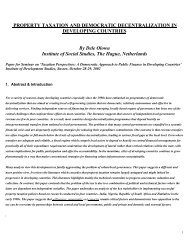View Article - Institute of Development Studies
View Article - Institute of Development Studies
View Article - Institute of Development Studies
You also want an ePaper? Increase the reach of your titles
YUMPU automatically turns print PDFs into web optimized ePapers that Google loves.
8Committee remarked insightfully “ what is all the more intriguing is that all these conceptualimages would co-exist side by side tending to militate against each other in the short-run”.This in turn may be juxtaposed with an earlier observation in this text that in the deliberations<strong>of</strong> the Constituent Assembly too these somewhat conflicting perceptions were present andwere ultimately papered over by bringing Panchayats under the ambit <strong>of</strong> the DirectivePrinciples.The Ashok Mehta Committee’s recommendations did not alter the fortunes <strong>of</strong> PRIsall at once. Their principal positive impact was in states which had their own compulsionsand motivations for devolution. The two leading examples are West Bengal and Karnataka.The former saw in devolution an opportunity to establish a rural base for the left partieswhich until then they had lacked. Also the government <strong>of</strong> the day sensed the possibility <strong>of</strong>thwarting any intervention against it from the center by creating for itself an alternativebase <strong>of</strong> support. In Karnataka the state’s first non-congress government sought to utilizePanchayat Raj in order to deepen the support for the party in the rural sphere where it wasrelatively weak. It should be added though that in both states there was an earnestcommitment to devolution and indeed in Karnataka it had formed part <strong>of</strong> the party’s electionmanifesto and this was assisted by the zeal <strong>of</strong> the minister for Panchayat Raj, the lateAbdul Nazeer Sab and the support he received from the chief minister Ramakrishna Hegde.The state-wise details are presented in the respective narratives. The principal point is thatthe Ashok Mehta report was <strong>of</strong> benefit to those states which had an expressed interest indevolution but did not create a new national ambience. At the same time its role in furtheringinterest in devolution should be acknowledged even if this took years to reach recognizablematuration. In other words the uneven performance <strong>of</strong> states on the Panchyati Raj frontcontinued post Ashok Mehta. In this one can discern the reasons for Constitutional statusnot succeededing in ushering in a new PR era.The next discernible policy shift took place in the eighties. Towards the end <strong>of</strong> thedecade the Union government at last introduced an amendment to the Constitution to conferthe status <strong>of</strong> units <strong>of</strong> governance on PRIs and Urban Local Bodies/ULBs. Before discussingthe amendment it is necessary to examine the background and the events leading up to this.To begin with major transformative changes were taking place in the economic front likethe New Economic Policy bringing in relaxation <strong>of</strong> controls and opening up the economyinternally as well as externally even prior to the formal adoption <strong>of</strong> Structural Adjustment.At the global level there were major developments which may be briefly summarized asfollows:





